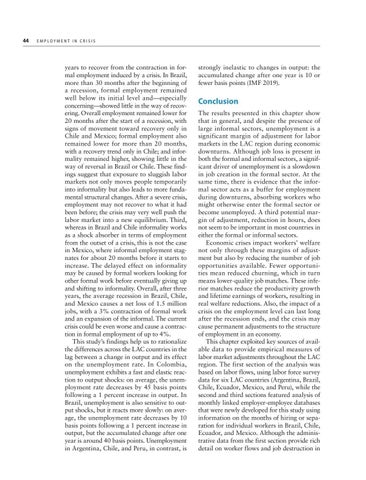44
Employment in Crisis
years to recover from the contraction in formal employment induced by a crisis. In B razil, more than 30 months after the beginning of a recession, formal employment remained well below its initial level and—especially concerning—showed little in the way of recovering. Overall employment remained lower for 20 months after the start of a recession, with signs of movement toward recovery only in Chile and Mexico; formal employment also remained lower for more than 20 months, with a recovery trend only in Chile; and informality remained higher, showing little in the way of reversal in Brazil or Chile. These findings suggest that exposure to sluggish labor markets not only moves people temporarily into informality but also leads to more fundamental structural changes. After a severe crisis, employment may not recover to what it had been before; the crisis may very well push the labor market into a new equilibrium. Third, whereas in Brazil and Chile informality works as a shock absorber in terms of employment from the outset of a crisis, this is not the case in Mexico, where informal employment stagnates for about 20 months before it starts to increase. The delayed effect on informality may be caused by formal workers looking for other formal work before eventually giving up and shifting to informality. Overall, after three years, the average recession in Brazil, Chile, and Mexico causes a net loss of 1.5 million jobs, with a 3% contraction of formal work and an expansion of the informal. The current crisis could be even worse and cause a contraction in formal employment of up to 4%. This study’s findings help us to rationalize the differences across the LAC countries in the lag between a change in output and its effect on the unemployment rate. In Colombia, unemployment exhibits a fast and elastic reaction to output shocks: on average, the unemployment rate decreases by 45 basis points following a 1 percent increase in output. In Brazil, unemployment is also sensitive to output shocks, but it reacts more slowly: on average, the unemployment rate decreases by 10 basis points following a 1 percent increase in output, but the accumulated change after one year is around 40 basis points. Unemployment in Argentina, Chile, and Peru, in contrast, is
strongly inelastic to changes in output: the accumulated change after one year is 10 or fewer basis points (IMF 2019).
Conclusion The results presented in this chapter show that in general, and despite the presence of large informal sectors, unemployment is a significant margin of adjustment for labor markets in the LAC region during economic downturns. Although job loss is present in both the formal and informal sectors, a significant driver of unemployment is a slowdown in job creation in the formal sector. At the same time, there is evidence that the informal sector acts as a buffer for employment during downturns, absorbing workers who might otherwise enter the formal sector or become unemployed. A third potential margin of adjustment, reduction in hours, does not seem to be important in most countries in either the formal or informal sectors. Economic crises impact workers’ welfare not only through these margins of adjustment but also by reducing the number of job opportunities available. Fewer opportunities mean reduced churning, which in turn means lower-quality job matches. These inferior matches reduce the productivity growth and lifetime earnings of workers, resulting in real welfare reductions. Also, the impact of a crisis on the employment level can last long after the recession ends, and the crisis may cause permanent adjustments to the structure of employment in an economy. This chapter exploited key sources of available data to provide empirical measures of labor market adjustments throughout the LAC region. The first section of the analysis was based on labor flows, using labor force survey data for six LAC countries (Argentina, Brazil, Chile, Ecuador, Mexico, and Peru), while the second and third sections featured analysis of monthly linked employer-employee databases that were newly developed for this study using information on the months of hiring or separation for individual workers in Brazil, Chile, Ecuador, and Mexico. Although the administrative data from the first section provide rich detail on worker flows and job destruction in

